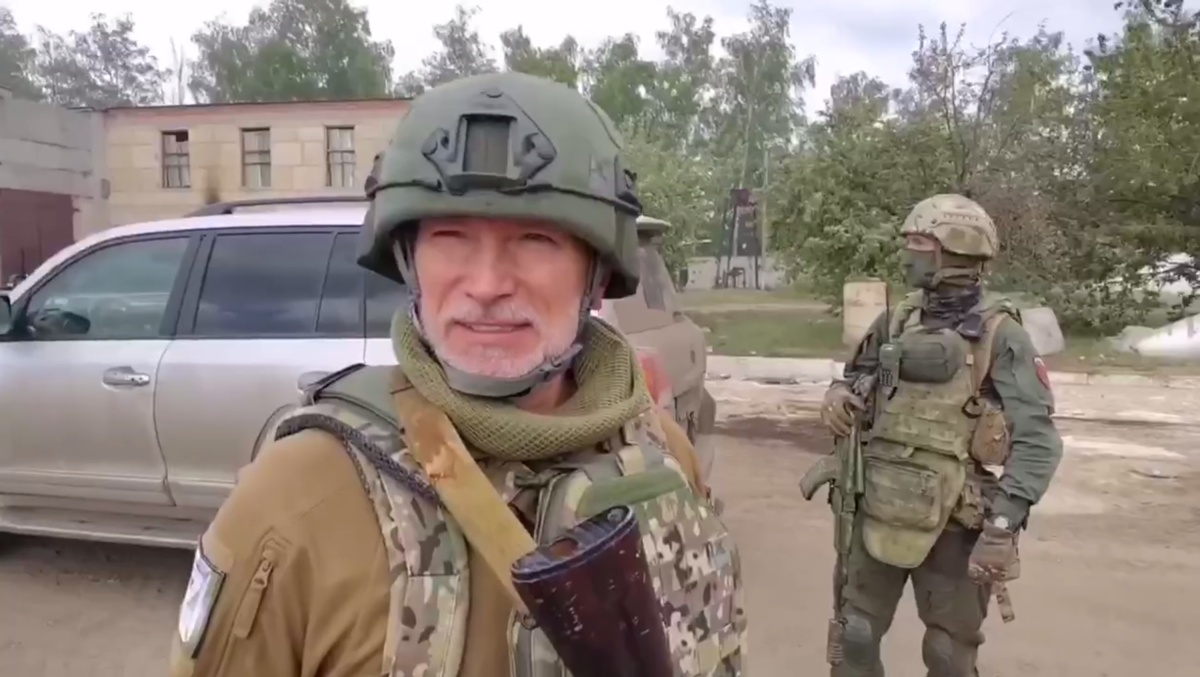Donbas Doubles: The Search for Girkin and Plotnitsky's Cover Identities
Flight booking data on the movements of two pro-Russian militants formerly active in the Donbas has yielded clues as to two possible cover identities, Bellingcat can reveal.
Igor Girkin, better known by his nom de guerre Igor Strelkov, was military leader of the ‘Donetsk People’s Republic’ (DNR) in 2014, while Igor Plotnitsky was head of the ‘Luhansk People’s Republic’ (LNR) from 2014 to 2017. Both men played a prominent role in the early politics of the two seperatist entities in Russian-occupied eastern Ukraine which this year were recognised unilaterally as independent states by Moscow shortly before its full-scale invasion of the country.
Travel booking data available via Russia’s data markets revealed that two individuals, ‘Sergey Runov’ and ‘Igor Plotnikov’, travelled alongside Girkin and Plotnitsky’s spouses — to the same locations and on the same dates as known public appearances of the two Donbas figures within Russia.
For example, all of Sergey Runov’s flight bookings were made alongside Girkin’s wife, while Girkin himself could not be found in any of the passenger manifests for these flights.
Further examination of the numbers of these internal passports — documents widely used by Russian citizens to travel within their country and to several neighbouring states — suggested that these identities were fictitious.
Intriguingly, although these passport numbers showed that they had been issued in, or for residents of, Moscow, no trace of these two men could be found in comprehensive tax or residency databases of the Russian capital. Moreover, the passport numbers were only digits away from what appeared to be other fictitious identities — some of which had also appeared in joint bookings alongside alleged agents of the FSB and GRU, Russia’s two main security services.
If these identities are indeed fictitious, it is highly unlikely that passports could have been issued for them without the knowledge or blessing of Russia’s security services. This raises further questions about the biographies of two of the most prominent leaders of pro-Russian forces in the Donbas region.
When approached by Bellingcat’s partner The Insider, Girkin refused to provide comment. His wife hung up after our reporter introduced himself. A spokesman for Girkin’s ‘Novorossiya Movement’ denied any knowledge of a ‘Sergey Runov’ having worked with the organisation.
Plotnitsky denied all knowledge of ‘Igor Plotnikov’, then hung up.
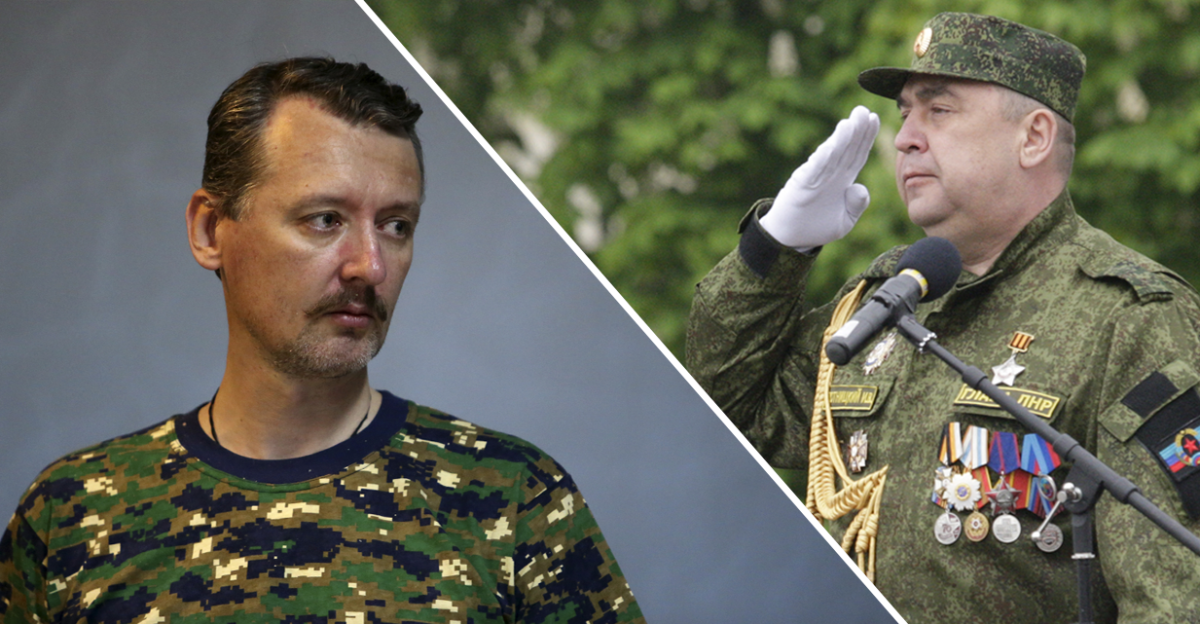
Pro-Russian separatist military commander Igor Strelkov attends a news conference in the eastern Ukrainian city of Donetsk July 28, 2014. REUTERS/Sergei Karpukhin and Igor Plotnitsky, the leader of the self-proclaimed Luhansk People’s Republic, salutes during the Victory Day military parade marking the World War II anniversary in rebel-held Luhansk, Ukraine, May 9, 2017. REUTERS/Alexander Ermochenko.
Igor Vsevolodovich Girkin and ‘Sergey Viktorovich Runov’
No military commander became more closely associated with the 2014 Russian intervention in Ukraine than Russian citizen and (former) FSB colonel Igor Vsevolodovich Girkin, better known in Russia by his chosen pseudonym Igor Ivanovich Strelkov.
Girkin gained a cult following among Russian nationalists that was first consolidated as the commander of the pro-Russian separatists during the first military confrontations with Ukrainian forces in the spring and summer of 2014. Having served a total of six months in Ukraine, Girkin resigned as the Donetsk People’s Republic’s (DNR) Defence Minister in August 2014 and returned to settle back permanently in Moscow. Back in Russia he retained his fame as a pundit on television and social media who over the years frequently advocated for an aggressive foreign policy in line with his own imperial nationalist and monarchist ideology. Internationally, Girkin became mostly infamous in relation to the MH17 downing — he is currently on trial in absentia in the Netherlands as one of four alleged co-conspirators in this crime.
Girkin has seemingly maintained a certain distance from the Kremlin, simultaneously criticising the Russian army’s actions in Ukraine while retaining certain loyalty to Moscow. For example, when he explained why he resigned as the DNR’s Defence Minister and left the Donbas, Girkin stated that this was due to “direct pressure” from the “Russian political leadership” which he submitted to because “I’m, after all, a Russian reserve officer and I feel a duty to my country. Even if I do not agree with a decision of the Russian political leadership, I still have to comply with it”. At the same time, he has emphasised that he never received official tasks since his dismissal from the FSB in the spring of 2013, and has frequently described himself as a military pensioner and an FSB Colonel in reserve who had appeared in Crimea and the Donbas on a voluntary basis.
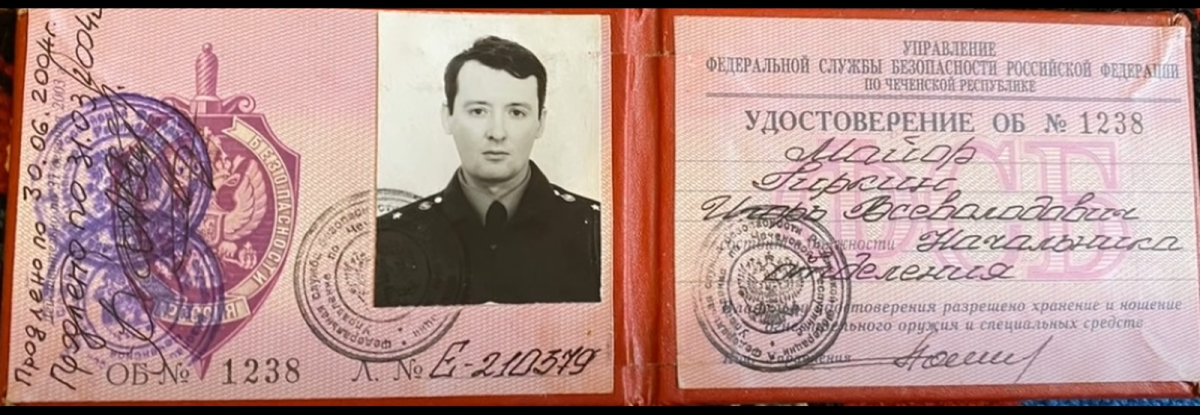
Photo of Girkin’s FSB card for the Chechen Republic (released by his close associate Mikhail Polynkov). ‘Memorial’ human rights activist Alexander Cherkasov has accused him of involvement in war crimes against Chechen civilians in 2001.
However, Bellingcat has discovered evidence that appears to connect Girkin to another Russian identity. This individual mostly travelled at the same time and to the same destinations where Girkin made public appearances, and all his domestic flights were jointly booked with Girkin’s wife, while an ‘Igor Girkin’ could not be found on any of the passenger manifests.

Personal booking data of ‘Sergey Runov’ for the 20 December 2014 flight from Moscow to Rostov-on-Don. The data indicates that the ticket was purchased six days in advance together with tickets for Miroslava Reginskaya and Evgeny Istyagin (then Chief of Staff of the ‘Novorossiya’ organisation).
On 17 December 2014, Girkin celebrated his 44th birthday by marrying 21-year-old Ukrainian Donbas-native Miroslava Reginskaya during a wedding ceremony in Moscow. Four days later, the newly wed couple appeared at a New Year’s gathering arranged for refugee children in the Russian city of Rostov-on-Don. A search in the domestic flight database, however, shows that when Reginskaya flew from Moscow to Rostov-on-Don on 20 December, and back two days later, she flew on jointly-purchased tickets with an individual listed in the databases as Sergey Viktorovich Runov, born 12 May 1970.
According to his Magistral record, the entirety of Runov’s travel history comprises ten flights and five train journeys, and according to the bookings database at least eight of these flights were jointly booked with Reginskaya. Furthermore, until 2016, there is no record of anyone named Igor Girkin on any of the flights taken by Reginskaya and Runov to various locations across Russia, despite him appearing at events beside his wife during these trips.
This raises the obvious question: Are Runov and Girkin one and the same?
Intriguingly, this Sergey Runov cannot be found in hundreds of leaked Russian residential databases, including the comprehensive Moscow citizen database Larix even though the passport number used by ‘Runov’ starts with 45 – the code allocated to Moscow residents or passports issued in Moscow. No such person appears in Russia’s comprehensive and publicly accessible tax database either. This is similar to other fictitious Russian identities covered by Bellingcat and partners, whose passport holders were implicated in assassinations attributed to the Russian state.
If Runov is a cover identity for Girkin, it would cast further doubt on the image of the former Donbas commander as an independent figure – not to mention raise questions about his operational security.
Such a cover identity could likely not have been issued without the knowledge or blessing of Russia’s security services.
Most trips by ‘Sergey Runov’ can be matched with Girkin’s public appearances outside of Moscow, Girkin made many such appearances in order to promote his Public Movement “Novorossiya”. This organisation was first introduced by the ex-commander on 30 October 2014 (about two weeks after he had returned to the political arena and declared his support for Putin). The organisation’s stated objective has been to facilitate the delivery of supposedly grassroots-collected material goods to the ‘LNR’ and ‘DNR’ under the guise of humanitarian aid, but since early 2015 the movement has been under European Union sanctions for its stated support to militia fighters.
Across his travel history, ‘Sergey Runov’ had multiple joint flight bookings with Reginskaya, who herself has held a senior position in the Novorossiya organisation since it was founded. For example, the two had a joint booking for a flight leaving in the early hours of 30 January 2015 from Moscow to Novosibirsk. Later that day, Girkin held a press conference in the Siberian city in which he announced the founding of a local branch of the Novorossiya organisation. He would later also appear on Novosibirsk local television for an interview. ‘Sergey Runov’ and Reginskaya had their return flight booked for the late afternoon of 1 March, and the next day local media reported that Girkin had left Novosibirsk.
Girkin at a press conference held at the Press Club of the Novosibirsk Union of Journalists, 30 January 2015
Another booking by ‘Sergey Runov’ and Reginskaya was a morning flight from Moscow to Perm on 12 March 2015. Later that day, Girkin held a press conference in which he presented the new Perm branch of the Novorossiya organisation. Two days later on 14 March, the ex-commander showed up on the other side of the Urals in the city of Yekaterinburg where he announced the establishment of another local branch. After the press conference, Girkin and Reginskaya were photographed leaving the venue in a Mercedes with a Perm licence plate, which suggests they had travelled to Yekaterinburg by car. The next day, Girkin reportedly visited some of Yekaterinburg’s churches and monasteries. His wife was also still in the city, evidenced by her sharing her location on VK at 12:46 pm. The couple presumably flew back home in the evening, as Reginskaya and ‘Sergey Runov’ had a booking, made one day prior, for a flight from Yekaterinburg to Moscow at 7:50 pm.
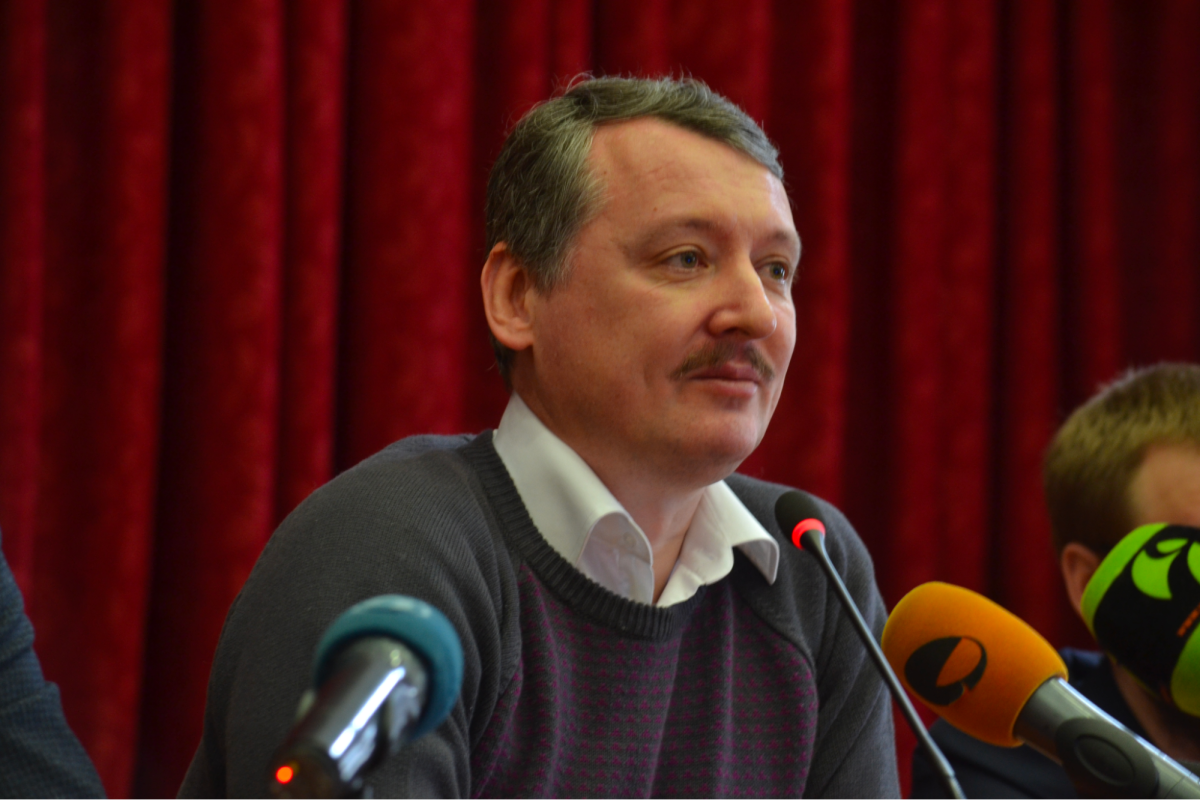
Girkin at the press conference in Yekaterinburg on 14 March 2015. Image CC BY-SA 4.0: Dom Kobb / Wikimedia Commons.
When exactly the ‘Sergey Runov’ passport was first issued remains unclear. According to Russia’s Magistral travel database, the passport was first used for a train ticket from Moscow to St. Petersburg on 25 November 2014, returning the next day (a video interview with Girkin on a local Saint Petersburg channel was aired on November 27). Since this was more than three months after Girkin had left the Donbas, the existence of this passport, had it been issued by the security services, cannot alone prove that he was an active secret service officer while fighting in Ukraine. At the same time, it is also not possible to exclude that he may by then have already received the ‘Runov’ passport.
The first of two ‘Runov’ passports found by Bellingcat has an official issuance date in 2002 or 2003, which can be concluded from the third and fourth digits of the passport number 4502322320 (which corresponds to the date of the passport form’s creation). However, this alone cannot be sufficient evidence to prove the fact that the passport was indeed issued in 2002, considering that the document may contain fake data.
What can be determined is that the ‘Runov’ passport was reissued at least once after Girkin returned to Russia. This happened sometime after ‘Sergey Runov’ turned 45 – an age at which Russian citizens need to obtain a new internal passport within a month – evidenced by the identity only appearing in travel databases under a new passport document number thereafter.

Flight bookings by “Sergey Runov” as contained in the leaked domestic flight bookings database of 2014–2016.
The earliest known use of the reissued passport was for a round-train trip from Moscow to St Petersburg on 31 October 2015, the same day that Girkin attended a conference in the city (the train journeys are visible in the Magistral database). The last known use of the older ‘Sergey Runov’ passport was for another return train trip to Russia’s northern capital on 15–18 May 2015.
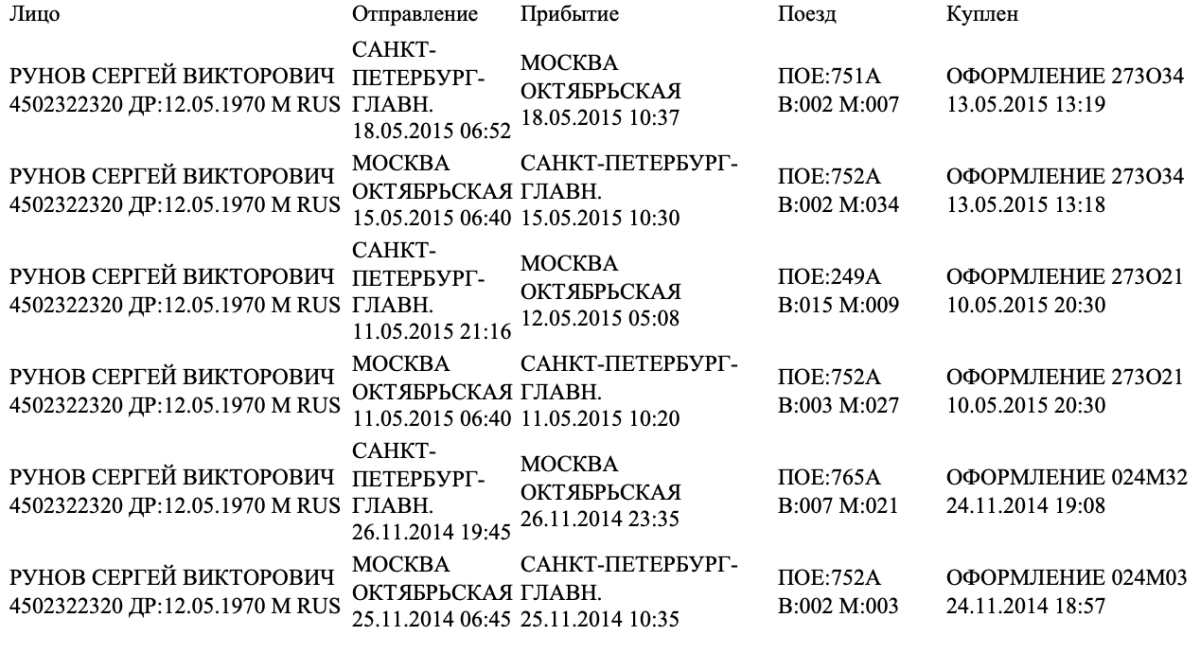
Train journeys found in the ‘Sergey Runov’ Magistral file.

Train journeys found in the ‘Sergey Runov’ Magistral file.
Not long after he first appeared in the Donbas, the Ukrainian authorities alleged that Girkin was a GRU agent, a label with which he was later also sanctioned by the European Union. In a leaked email seen by Bellingcat and reported on by Ukrainian outlet Insider.UA, Girkin claimed that after his dismissal from the FSB in 2013 he officially only worked as chief of security of the Marshall Capital firm of Konstantin Malofeev, a Russian oligarch and like-minded proponent of Russian irredentism who has reportedly financed pro-Russian separatist activities in Ukraine, for which he was recently indicted by the US authorities.
Yet other, now public, information suggests that Girkin was taking orders from an FSB officer while in Ukraine. Intercepted telephone conversations released by the Dutch-led Joint Investigation Team (tasked with investigating the MH17 downing) indicate that in the summer of 2014 Girkin took orders from ‘Vladimir Ivanovich’, the pseudonym of a curator of the separatists whom Bellingcat and partners later identified as Colonel General Andrey Burlaka – at the time the Chief of the Operational Staff of the FSB’s Border Service. Furthermore, a leaked draft letter from Burlaka to FSB chief Alexander Bortnikov from July 2014 shows him requesting a fake Russian passport for an unknown DNR leader living in the occupied-areas. As mentioned in previous reporting on Burlaka, Bellingcat was unable to independently authenticate the leaked document nor establish whether it was sent – although it did appear to include non-public information and reference several real email addresses.
A closer examination of the document numbers of the ‘Sergey Runov’ passport points in the direction of his former employer, the FSB. A search in the flight bookings database for passport document numbers within a range of about 100 places of the first ‘Sergey Runov’ passport, for example, brings up the flight history of six individuals who, like ‘Runov’, cannot be found in other available Russian databases. At least two of the six can be linked to apparent FSB operatives who have been documented travelling under false identities.
One of the six passports was issued in the name of ‘Anatoly Yashin’ who had a booking in April 2016 for a return flight from Moscow to Minsk together with ‘Alexey Kornilov’. The latter’s passport document number is found to be from the same batch as that of ‘Ekaterina Zotova’ (38 numbers apart) who was previously identified by Bellingcat as the fake identity of the wife of convicted FSB assassin Vadim Krasikov. Another one of the six passport was issued with the name ‘Artyom Vinogradov’, who in March 2015 flew on a joint booking with ‘Mikhail Stepanov’ – the cover identity of FSB poison squad member Mikhail Shvets implicated in the Alexey Navalny operation. In May and October 2014, the same ‘Artyom Vinogradov’ also had joint flights with ‘Bulat Rinatovich Akhmedov’ (b. 03.06.1987) whose passport is from the same range as that of ‘Vladimir Alekseev’ – the cover identity of implicated FSB poison squad member Vladimir Panyaev.
The reissued ‘Sergey Runov’ passport can also be linked to identified FSB operatives via the same method. This passport is just two numbers removed from a passport ascribed to ‘Andrey Popov”. This individual did not appear in any other databases but had two joint bookings with ‘Aleksandr Rysakov’, another person whose absence in other databases suggests is non-existent. He, in turn, had a joint booking with a ‘Sergey Zibrov’, who appears in no other databases and whose passport document number is just one away from that of ‘Ivan Makarov’. The latter, in turn, had joint bookings with the seemingly non-existent ‘Aleksandr Maksimov’, whose passport document number is from the same batch (86 numbers apart with other suspected false passports in-between) as that of the aforementioned ‘Mikhail Stepanov’ (FSB poison squad member Shvets).
The last known use of this ‘Sergey Runov’ passport was in early 2016. It concerned a flight booked with Reginskaya from Moscow to Stavropol on 14 February with a return ticket three days later. These dates coincided with Girkin’s three day stay in Stavropol, which included two press conferences and a visit with his wife to the studio of a local artist, amongst other meetings. A few weeks later, on 11 March, a passport under Girkin’s actual name was used for a joint booking with Reginskaya for a flight from Moscow to Yekaterinburg (a few days later Girkin gave lectures in the neighbouring city of Chelyabinsk).
A final clue came on Girkin’s VKontakte page that same year, when he shared family history documents according to which Runov was the surname of his maternal grandfather, as well as the maiden name of his mother (Runova).
Bellingcat’s partner The Insider approached Girkin for comment. Reporters telephoned Girkin to ask why he appeared to use a passport under the name Sergey Runov and why, if he is no longer an active member of the security services, he has access to a passport under a different name.
“I’m not commenting on any of the subjects you’re talking about”, responded Girkin.
Alexey Sorokovoy, Chief of Staff of Girkin’s ‘Novorossiya Movement’ denied any knowledge of a ‘Sergey Runov’ having worked with the organisation.
“That name isn’t familiar to me, but that means absolutely nothing as various people worked with us”, said Sorokovoy when contacted.
Reginskaya, named on the Novorossiya Movement’s website as the head of its women’s council, hung up after our reporter from The Insider introduced himself and asked why she had travelled with ‘Runov’.
Igor Venediktovich Plotnitsky and ‘Igor Vladimirovich Plotnikov’
One of the most important leaders of the separatists during the early years of the Donbas conflict was Ukrainian citizen Igor Venediktovich Plotnitsky (b. 24 June 1964) who served as the Head of the ‘Luhansk People’s Republic’ (LNR) for more than three years until late 2017. In this capacity, he was one of the signatories of the Minsk agreements of 2014 and 2015 which led to the failed truce between Russia and Ukraine (despite daily violations, the truce remained in effect until Russia’s recent large-scale invasion).
An ex-Soviet army officer with the rank of Major and former civil servant, Plotnitsky first came to public attention as the first commander of the “Zarya Battalion” which appeared in April-May 2014 in his hometown Luhansk (the battalion ceased to exist by late 2014 when its units were incorporated into the LNR’s ‘People’s Militia’). Plotnitsky was appointed Defence Minister of the LNR on 21 May 2014 and elected Head of the LNR via the republic’s general election of 2 November 2014, which was supported by Russia but condemned by Ukraine as illegitimate. No election monitors from the OSCE were present on election day; the few international observers were from pro-Russian or marginal far-right groups.
According to human rights watchdogs, the LNR under Plotnitsky was characterised by lawlessness and authoritarian rule, with a non-transparent justice system and deep dependence on neighbouring Russia. Plotnitsky’s stated position was that the LNR would eventually join Russia via a referendum like the one held in Crimea in 2014.
Several observers have written about suspicions that Plotnitsky answered to the Russian security services. Furthermore, the Ukrainian security services later published an intercepted conversation between Plotnitsky and Dmitry Utkin, reported field commander of the Wagner group, from January 2015 in which Plotnitsky is heard telling the latter “it would have been difficult without you”.
As in the case of Girkin, this apparently fictitious identity was discoverable because it was used for the booking of a flight together with his wife, Larissa Plotnitskaya (who reportedly passed away in 2020). This concerned one of the five flights booked for the passport contained in the bookings database. Some of the trips also appear to match with Plotnitsky’s trips outside of Ukraine.
Booking records show that on 7 November 2014 Plotnitskaya had a booking for a flight from Rostov-on-Don to Moscow together with Russian citizen Igor Vladimirovich Plotnikov whose stated birthdate is 24 June 1964 – the same as that of Plotnitsky. The two surnames also share the same root, the only difference being two different common Slavic suffixes (-kov and -nitsky).
The exact reason for the journey to Moscow is unknown, but it is notable that Plotnitsky was inaugurated as the Head of the ‘LNR’ just three days earlier in the presence of his wife (note that Rostov-on-Don is the closest significant airport in Russia which is well linked to the Russian occupied territories of eastern Ukraine). Furthermore, flight data indicates that his then-counterpart Alexander Zakharchenko (assassinated in 2018), who was sworn in as Head of the ‘DNR’ on the same day as Plotnitsky, also flew from Rostov-on-Don to Moscow shortly after the inaugurations (using his Ukrainian passport), which further suggests that these journeys were likely business trips.

Travel database entry for a November 7, 2014 joint trip showing ‘Igor Vladimirovich Plotnikov’ and Larisa Plotnitskaya.
The earliest known use of the ‘Igor Plotnikov’ passport was for the booking of a flight from Rostov-on-Don to Moscow on 4 September 2014, which was one day before Igor Plotnitsky appeared in Minsk together with Zakharchenko in order to sign the Minsk Protocol. It is not clear how he travelled from Moscow to Minsk, and there is no record in acquired databases of travel on the Plotnitsky or Plotnikov passports at this time. ‘Igor Plotnikov’ had a second booking for the same itinerary on 12 September, with a return ticket the next day, but Plotnitsky’s whereabouts on those days are less clear.
‘Plotnikov’ also had a booking for a flight from Rostov-on-Don to Moscow on 18 September 2014, and the next day Plotnitsky and Zakharchenko again appeared in Minsk in order to sign the follow-up memorandum to the Minsk Protocol. Again, it is not clear how the two reached Minsk, and there is no record in acquired databases of them travelling on the Plotnitsky ‘Plotnikov’ or Zakharchenko passports on 19 September. Nevertheless, the databases do show that on the same day, two tickets were booked for the two separatist leaders for a flight back from Moscow to Rostov-on-Don on 20 September. For this booking, Plotnitsky’s Ukrainian passport was used.

Trips using the ‘Igor Vladimirovich Plotnikov’ passport in 2014.
Based on the available travel data, the ‘Plotnikov’ passport was no longer used after the trip with Plotnitskaya in November 2014. Plotnitsky continued to travel to Russia and Belarus over the next few years, but the data indicates he used his Ukrainian passport for these trips.
That ‘Igor Plotnikov’ is a fictional persona is further suggested by a searches in the Moscow citizen database Larix (like “Runov”, the passport number of “Plotnikov” starts with 45 – the area code for Moscow) and the publicly accessible tax database yielding no results.

Empty search results for the ‘Igor Plotnikov’ identity in Russia’s online tax database.
Bellingcat has been able to compare the ‘Igor Plotnikov’ passport’s document number to that of other distinguishable false identities contained in a backlog of presumably secret service-issued passports accumulated during previous investigations. This has shown that the document was issued from the same range as passports used by known GRU members.
For instance, a passport with a document number only one digit below that of ‘Igor Plotnikov’ was used by an individual using the identity ‘Nikolay Konstantinovich Alekseevich’, born 07.04.1980. Similarly, no further information on Alekseevich can be found in other databases on Russian citizens. Yet in 2017 he had two joint trips to Minsk together with Alexey Minin, who was detained in the Netherlands in 2018 during what the Dutch and UK Authorities stated was a foiled GRU hacking operation targeting the OPCW.
Plotnitsky resigned as the Head of the LNR in late 2017 and fled to Moscow during a sudden power struggle in the separatist ‘republic’ (which also reportedly involved the Wagner Group). His use of a Russian telephone number, which when contacted did not appear to use roaming, suggests that there is some truth to media reports that he has lived in exile in Russia since losing his position.
He is still wanted by Ukraine on terrorism charges, and in 2021 a Ukrainian court sentenced him in absentia to life imprisonment for allegedly ordering the June 2014 shootdown of a Il-76 transport aircraft which killed 49 Ukrainian servicemen.
Reporting partner The Insider contacted Plotnitsky to ask how he appeared able to use a passport under the name ‘Igor Plotnikov’ on several occasions in 2014.
“How should I be able to remember where I travelled in 2014?” responded Plotnitsky, having denied all knowledge of the issue.
Our reporter suggested that November 7, 2014 should have been a memorable date as it was immediately after Plotnitsky became head of the ‘LNR’.
Plotnitsky then hung up.
This investigation was conducted by Bellingcat and The Insider. Pieter van Huis and Christo Grozev served as the primary researchers for Bellingcat, with reporting from The Insider’s Roman Dobrokhotov.
Bellingcat is a non-profit and the ability to carry out our work is dependent on the kind support of individual donors. If you would like to support our work, you can do so here. You can also subscribe to our Patreon channel here. Subscribe to our Newsletter and follow us on Twitter here.


